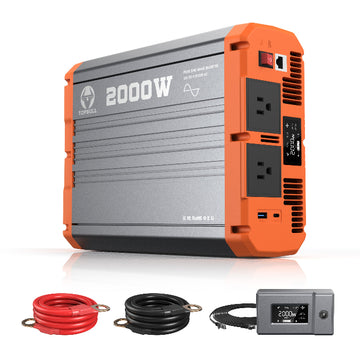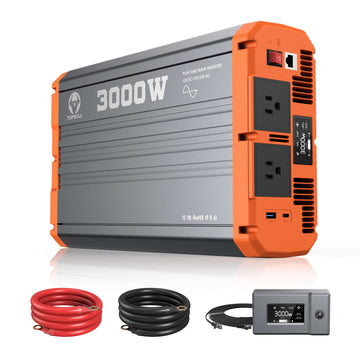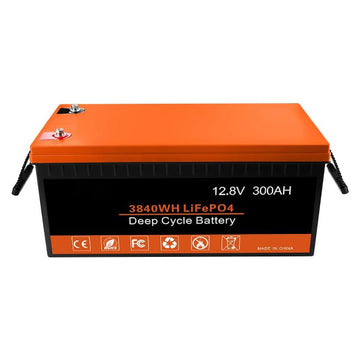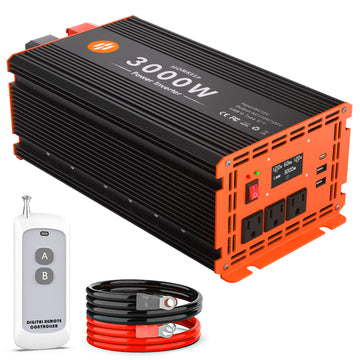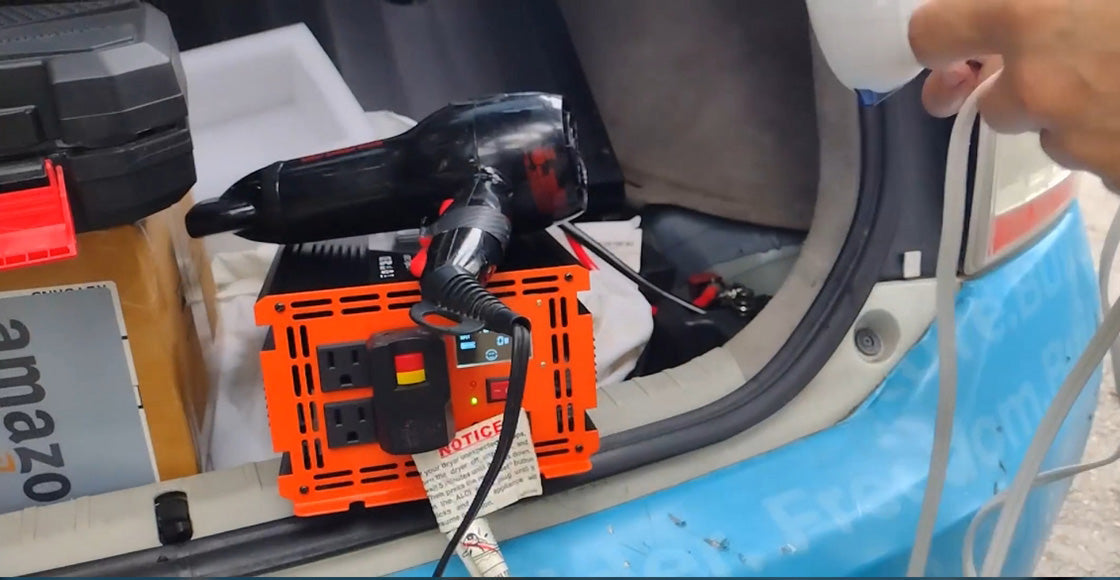Portable Inverter Buying Guide: The Best Choice to Ensure Your Energy Needs
Provides a thorough inverter buyer's guide to help readers understand the basics of inverters, buying pointers, and steps to take in order to make an informed buying decision.

liberry
Feb 13, 2025
Portable power inverter, as an indispensable and important device in modern life, is especially important during outdoor adventures or home power outages. It is capable of converting DC power from solar panels or batteries into AC power, providing us with a stable source of electricity. However, there are many kinds of inverters in the market, how to choose a suitable one for you? This article will provide you with a detailed portable inverter buyer's guide to help you easily master the skills of buying and using an inverter, from understanding the basic concepts of inverters to the key considerations in the purchasing process to the FAQs in actual use.

Table of Content
- What is Portable Inverter
- Types of Portable Inverters
- Specific Steps and Advice for Buying the Right Inverter
- Best Inverter Recommendation
- Why Buy Inverters from Topbull Store
- How to Choose the Right Battery for Your Inverter
- 12V Lithium Battery Recommendation
- FAQs About Buying an Inverter
What is Portable Inverter
An inverter is a power conversion device whose core function is to convert direct current (DC) to alternating current (AC). This conversion capability enables us to utilize a wide range of DC power sources, such as car batteries, solar panels, etc., to generate AC power that meets household or industrial standards to satisfy the power needs of various types of electrical devices. The portable inverter is a compact inverter designed for outdoor or off-grid environments. It is lightweight and portable, ideal for camping, emergency backup power and off-grid scenarios, providing a reliable solution for users' outdoor activities or temporary power needs.
Types of Portable Inverters
Portable inverters are categorized primarily based on their output power, type of waveform and the purpose for which they are designed:
By output power: small inverters may only have a few hundred watts, suitable for charging laptops and cell phones, while large inverters can reach several kilowatts, enough to supply the power needs of an entire home or small commercial premises.
By Waveform Type: The main categories are Pure Sine Wave Inverter and Modified Wave (Square or Quasi Sine Wave) Inverter. Pure Sine Wave Inverters produce a current waveform closest to the grid supply and are suitable for sensitive electronic equipment, while Modified Wave Inverters are less costly but may cause damage to some equipment or operate inefficiently.
By design use: e.g., vehicle inverters, home inverters, solar inverters, etc., each optimized for a specific application scenario.
Specific Steps and Advice for Buying the Right Inverter
DC Voltage Adaptation
Before shopping for an inverter, you first need to determine the voltage range of your existing DC power source, such as a battery bank or solar panel. The inverter needs to be compatible with the DC voltage you provide in order for it to work properly. For example, if your battery bank is 12V, then you will need to choose an inverter that can accept a 12V DC input.12V inverters are designed to handle and convert 12V, and connecting them to 24V batteries could cause damage to your equipment or lead to safety issues such as fire. Therefore, ensuring that the DC voltage is suitable is the first step in the purchasing process, which can effectively avoid the problem of incompatible devices.
Define the Usage Scenarios
Determine the scenario in which the inverter will be used, such as camping, RV, emergency backup power, etc. This will help in determining the power requirement and the environment in which the inverter will be used.
Application Scenarios and Power Requirements
Small power demand:For small devices such as cell phones, cameras, laptops, etc., generally choose a portable inverter with an output power of less than 300W to meet the charging or usage demand.
Medium power demand: For camping lights, stereos, car refrigerators, fans and other devices, it is recommended to choose portable inverters with output power between 300W and 1000W.
High power demand: For power tools, microwave ovens, drills and other high-power devices, you need to choose a portable inverter with an output power of more than 1000W. However, it should be noted that high-power devices may require higher instantaneous power (i.e. peak power) during startup, so when choosing an inverter, you should ensure that its peak power can meet the startup demand of the device.
Calculate How Much Power Inverter is Needed
Practical Steps
Determining how much power you need from your inverter is a critical step in ensuring that your system operates properly. Here are some practical steps and methods to help you calculate the required power:
Calculation Example
Suppose there is a home with the following equipment that requires electricity:
| Device | Normal Operating Power (W) | Peak Power (W) (Assumed) |
|---|---|---|
| Refrigerator | 300 | 600 |
| Television | 200 | 200 |
| Computer | 150 | 150 |
| Air Conditioner | 1500 | 2500 (During startup) |
| Microwave Oven | 1200 | 1800 (Initial heating phase) |
We need to calculate the power specifications of the required inverters to ensure that all devices are powered safely and consistently.
First, we list the common operating power of each device, and by adding up these powers, we get a total common operating power of 3350W.
However, we also need to consider the peak power of the devices, such as refrigerators, air conditioners, and microwave ovens, which all start up with peak power. Therefore, we add their peak power to the ordinary operating power of the other devices to get a total peak power of 5250W.
To ensure that the inverter can cope with this peak load and to allow some margin for other possible load variations, we added a margin of 30%. This gives us an inverter rated power requirement of 4355W and a peak power requirement of 6825W
(However, please note that this is only a theoretical calculation value, the actual selection needs to be adjusted according to the specific use scenarios and equipment load conditions)
Rated and Peak Power of the Inverter
The rated power and peak power of an inverter are two important parameters that describe its output capability.
Rated Power
Rated power, also known as continuous output power, is the power that the inverter is able to provide over a long period of time in a steady state of operation. This is a basic specification for inverter design and indicates that the inverter is capable of providing power to the load in a continuous and stable manner. For example, if an inverter is rated at 2000 watts (W), it can provide 2000 watts of power to the load steadily over a long period of time without damage.
Peak Power
Peak power, also known as maximum power or start-up power, is the maximum power that an inverter can provide in a short period of time, usually within 20 milliseconds. This parameter is mainly used to describe the inverter's ability to cope with instantaneous high power demands. For example, some appliances with electric motors (e.g., refrigerators, washing machines, drills, etc.) require a high current to propel them during startup, and this is where the peak power of the inverter becomes particularly important. If the peak power of the inverter is not sufficient to meet the start-up demand of the appliance, then the appliance may not start properly.
Relationship Between Rated Power and Peak Power
- Numerical relationship: Peak power is usually 2 to 3 times the rated power. This means that if an inverter is rated at 1000 watts, its peak power may be between 2000 and 3000 watts.
- Application Scenario: Rated power is more suitable for describing the inverter's output capability under long time, stable working condition; while peak power is more suitable for describing the inverter's capability to cope with instantaneous high power demand.
When purchasing an inverter, consumers should choose the right power according to their actual needs. For general household appliances, the rated power is of greater reference value; while for appliances with electric motors, it is necessary to consider whether the peak power of the inverter is sufficient.
Choosing the Right Inverter Waveform
Choosing the waveform of the inverter is crucial because it is directly related to the compatibility of the equipment, power quality, electromagnetic interference control and the applicability of the application scenarios. Pure Sine Wave Inverters are more popular due to their high-quality output waveforms and stable performance characteristics, which can satisfy occasions with high power requirements, while Modified Wave Inverters are suitable for simple electrical equipment with low power quality requirements.
Pure Sine Wave Inverter vs Modified Wave Inverter
When choosing between a pure sine wave inverter or a modified wave inverter, several factors need to be considered, including the type of power-using equipment, power quality requirements, budget, and the scenario in which the inverter will be used. The following is a detailed comparison and analysis of the two types of inverters
| Item | Pure Sine Wave Inverter | Modified Sine Wave Inverter |
|---|---|---|
| Output Waveform | Close to ideal sine wave, smooth without abrupt changes | Sawtooth-like waveform with obvious distortion |
| Power Quality | High quality, suitable for devices sensitive to power waveforms | Lower quality, may adversely affect certain devices |
| Scope of Application | Wide, suitable for most electronic devices, especially sensitive ones | Limited, mainly suitable for devices with low power waveform requirements |
| Device Protection | Provides better device protection, reduces the risk of device damage | Poor device protection ability, may lead to overheating and damage of devices |
| Energy Efficiency | Usually higher, with good energy conversion efficiency | May have reduced energy efficiency due to waveform distortion |
| Price | Relatively high, priced due to complex structure and high-quality output | Relatively low, priced due to simple structure and lower-quality output |
| Compatibility | Compatible with various load types, providing stable power output | May experience instability with certain load types |
| Technical Complexity | High, with a complex internal structure and technical challenges | Lower, with a relatively simple internal structure |
Selection Tips
Appliances for which the Modified Wave Inverter does not work properly
Because of the nature of the output waveform, Modified Wave Inverters may not work properly with certain specific types of appliances. The following are some of the appliances that are not normally recommended for use with Modified Wave Inverters, please take this into consideration when buying them
| Electrical Appliance Type | Specific Examples | Potential Issues |
|---|---|---|
| Electric Motor Appliances | Washing Machines, Electric Fans, Vacuum Cleaners, Mixers, etc. | High starting current, unstable operation, potential motor damage |
| Compressor Appliances | Refrigerators, Air Conditioners, Ice Makers, etc. | Insufficient power to support startup and operation, poor cooling/heating performance |
| Relays and Contactors | Various industrial automation relays, contactors, solenoid valves, etc. | Frequent failures or damage, unreliable operation, affecting system stability |
| Lighting Equipment | Fluorescent Lights, Some LED Lights, etc. | Flickering, stroboscopic effect, failure to illuminate or unstable brightness |
| Precision Electronic Devices | High-end Audio Equipment, Medical Devices, Precision Measurement Instruments, etc. | Performance degradation, data errors, device damage |
| Devices with Synchronous Motors | Certain types of fans, mixers, pumps, etc. | Unstable speed, vibration, increased noise |
| Chargers for Small Battery-Powered Devices | Flashlights, Cordless Razors, Toothbrush Chargers, Mobile Phone Chargers, etc. | Inability to charge, slow charging speed, battery damage |
| Kitchen Appliances | Microwaves, Rice Cookers, Electric Ovens, Coffee Makers, etc. | Uneven heating, inability to start, damage |
| Security Monitoring Devices | Cameras, Alarm Systems, Access Control Systems, etc. | Blurred images, false alarms, inability to function properly |
Please note that this table is not absolute, as the sensitivity of appliances to power waveforms may vary between makes and models. In addition, the quality and performance of the Modified Wave Inverter may also affect its compatibility with appliances.
Selection Advice
Overall, pure sine wave inverters show significant advantages in terms of output waveform quality, applicability, equipment protection, energy efficiency, as well as compatibility and stability. Therefore, when high quality power output is required, it is wiser to choose pure sine wave inverters. Of course, pure sine wave inverters are usually more expensive, but the investment is worth it when considering their long-term benefits and equipment protection.
Examining the Performance Metrics of the Inverter
Excellent conversion efficiency
Meaning: Conversion efficiency is the efficiency of an inverter in converting DC power to AC power, usually expressed as a percentage. It reflects the size of energy loss in the conversion process of the inverter.
Standard: The conversion efficiency of high quality inverters should be above 90%, and some high-end products can reach 95% or higher. The higher the conversion efficiency, the higher the energy utilization.
Stable Rated Output Frequency
Meaning: The frequency of the output voltage of the inverter should be a relatively stable value, usually 50Hz (or 60Hz, depending on the region) of the industrial frequency.
Standard: The rated output frequency of high quality inverter should be within ±1% deviation under normal working conditions.
Low total harmonic distortion
Meaning: THD measures the relative proportion of harmonic components in the output current of the inverter and reflects the distortion of the current waveform. A lower THD indicates a higher quality output current, which is friendlier to electrical equipment.
Standard: Quality inverters should have a THD of less than 5%, ideally 3% or less, to ensure safety and stability for sensitive electronic equipment.
Load Power Factor
Meaning: Load power factor characterizes the inverter's ability to carry inductive or capacitive loads. The level of load power factor directly affects the inverter's ability to carry loads and its efficiency. For inductive loads, the power factor will drop, so the inverter needs to have sufficient power factor correction capability.
Standard: Load power factor of sine wave inverter is 0.7~0.9, rated value is 0.9. Under the condition of certain load power, higher power factor means better load carrying ability of inverter and higher system efficiency.
Starting Performance
Meaning: Starting performance refers to the inverter's ability to start with load and its dynamic working performance.
Standard: The inverter should be able to ensure its normal startup under the rated load. For inductive loads, such as electric motors, the inverter needs to withstand large surge power. Therefore, the starting performance is one of the important indexes to measure the performance of the inverter. High-performance inverters should be able to quickly adjust the output voltage and frequency to maintain stable operation when the load changes suddenly.
Good Thermal Management
Meaning: The thermal design of an inverter, including fan cooling or other cooling mechanisms. A good thermal management system improves the performance and lifetime of the inverter and reduces the risk of failure due to overheating.
Standard: High quality inverters are equipped with efficient cooling systems (e.g. automatic fan control or heat spreading materials) that can maintain stability in high temperature environments and avoid overheating damage.
Multi-Protection Mechanism
Meaning: The protection function refers to the inverter's ability to protect itself in time to prevent equipment damage and safety hazards under abnormal conditions.
Standard: High-quality inverters should have complete protection functions to cope with all kinds of abnormal situations that occur during actual use. These protection functions include input under-voltage protection, input over-voltage protection, output short-circuit protection, input reverse connection protection, over-current protection, lightning protection and over-temperature protection.
Inverter Noise Level
Meaning:
The size of the sound produced by an inverter during operation is usually expressed in decibels (dB). As an electronic device, an inverter contains transformers, filter inductors, electromagnetic switches, fans and other components, which generate a certain amount of noise during operation.
Standard: The noise generated during normal operation of the inverter should not exceed a certain level. Typically, the noise level of an inverter should not exceed 80 dB(A) and the noise level of a small inverter should not exceed 65 dB(A). Low noise inverters help to minimize disturbance to the environment and users.
Multi-Protection Mechanism
Meaning: The ability of an inverter to maintain stable operation and meet performance requirements under specific environmental conditions. This capability covers the inverter's ability to withstand a wide range of environmental factors, including temperature, humidity, vibration, shock, salt spray, dust, etc.
Standard: High-quality inverters are able to operate over a wide range of operating temperatures (e.g. -20°C to +50°C) and are IP rated (protected) against moisture and dust.
Buying Advice:
The above performance criteria should be looked at when choosing a quality inverter. This will help you evaluate the quality and suitability of different products and ensure that the inverter you ultimately choose will meet your needs and provide consistent performance.
Consider the Additional Functionality and Value of the Inverter
Smart Recognition of Conversion Voltage
Intelligent recognition of conversion voltage is also a highlight when buying an inverter. This function enables the inverter to automatically recognize and adapt to different voltage environments, such as 110V or 120V, without the need to manually adjust the settings to ensure that the device can work properly in different countries and regions. This not only avoids the risk of equipment damage due to voltage mismatch, but also greatly simplifies the user's operation process and improves the overall user experience!
Enough Power Outlets and USB Ports
The configuration of sockets and USB ports varies significantly from one inverter model to another. Some inverters may be equipped with only one socket for basic power output, while some higher-end, more feature-rich inverters may offer multiple sockets for connecting and powering more devices. In terms of USB ports, the inverter may also provide one or more ports, and the types of these ports may also vary, including the common USB-A ports and the more advanced USB-C fast-charging ports. It's worth noting that topbull inverters do a particularly good job in this regard. They are all equipped with 2 US standard AC power outlets, as well as USB ports and Type-C fast charging ports, which is more than enough for the average user's daily needs.
Consider the Price Cost of the Inverter
Prices Vary for Different Types of Inverters
The amount of power output from the inverter is an important factor that directly affects the price. The higher the power, the more expensive it tends to be, as higher power inverters require more complex designs and higher quality materials to ensure safety and stability.
Pure Sine Wave Inverters Cost More
Pure Sine Wave Inverters are usually more expensive than Modified Wave Inverters due to their high quality output waveforms, wide range of applications, multiple protection features, and higher investment in technological research and development, but offer a more stable power solution that is compatible with a wider range of devices.
The Technical Process of the Inverter Affects the Price
MPPT (Maximum Power Point Tracking) technology: MPPT-equipped inverters are more expensive, but can increase the efficiency of a solar system by 10-30%.
Topology: High-frequency inverters (small and efficient) can be 30-50% more expensive than industrial frequency inverters (durable but bulky).
Components: Inverters using silicon carbide (SiC) or gallium nitride (GaN) semiconductor components are more efficient, but can cost twice as much.
Thermal Design: Liquid cooling is usually more expensive than air cooling in a thermal design.
It is worth noting that even for the same type of inverter, prices can vary significantly between brands. In the portable inverter market, Topbull inverters show a significant advantage with competitive pricing. For the same power and quality, Topbull inverters are more than 30% less expensive compared to other brands on the market. This ensures that users can enjoy a very high price/performance ratio while obtaining stable power frequency and high quality power, thus meeting the diversified needs of different consumers.
To Summarize
Choosing an inverter is a comprehensive decision-making process that involves needs analysis, performance evaluation, brand reputation, budget planning and value-added considerations. Through careful consideration and comparison, you will be able to find the inverter that meets your current needs, has the potential for future expansion, and has the perfect balance of price and performance to provide a stable, efficient and reliable solution to your power needs.
Best Inverter Recommendation
1. Home Off-Grid Photovoltaic Systems
In an off-grid PV system, the inverter's ability to operate independently is critical. It must be able to continuously supply power to the home or equipment without grid power. An effective inverter should have enough power to meet the maximum power demand of the home or equipment, while at the same time being more than 90% efficient to optimize the performance of solar power generation.
The Topbull 3000W Pure Sine Wave Inverter is ideal for this requirement. Not only does it fulfill all of the above conditions, it is also compatible with a wide range of battery types and is equipped with a highly efficient battery management system to ensure safe and stable charging and discharging. At the same time, its excellent durability and easy maintenance enable it to cope with harsh environments, making it suitable for long-term use in remote areas.
The Most Cost Effective Off-Grid Inverter: Topbull Pure Sine Wave Inverter

- Various Power Options: 2KW,3 kW,4 kW
- High Efficiency and Stability: Highly efficient conversion of electrical energy, stable and continuous rated power output
- High-quality Output: Stable voltage, small fluctuation rate, low distortion rate, to meet the needs of high-standard power supply.
- Durable and Build Resistant: Designed for harsh environments, the case is hard and durable, with dustproof and waterproof performance.
- Widely Compatible: Compatible with many types of batteries to meet diversified power needs.
- Safe and Convenient: Equipped with comprehensive protection mechanism to ensure the safety of power consumption.
2. Outdoor Camping & RV Traveling
Outdoor camping, RV travel inverter requires high and stable power conversion efficiency, sufficient output power to meet the needs of various types of electrical loads, but also has good durability, adaptability and safety. It is recommended to choose pure sine wave inverter, the output waveform is good, the distortion is small, the interference to the power equipment is small, the protection function is complete, can meet the RV travel to the demand for high quality power supply, to ensure the normal operation of the power equipment and the safety of electricity. You can also consider buying Modified Wave Inverter, which is more affordable, but consider the types of appliances supported by Modified Wave Inverter
Best Pure Sine Wave Inverter for Camping: Topbull 2000W Pure Sine Wave Upgrade
Best Selling Modified Wave Inverter on Amazon:Topbull 3000W Modified SIne Wave Inverter
Why buy an inverter from Topbull?
How to Choose the Right Battery for Your Portable Inverter
Batteries provide a stable and continuous DC power supply, and inverters are the devices that convert this DC power to AC power. In the case of off-grid or power outage, the inverter with battery can be used as a backup power source, which can ensure the normal operation of critical equipment. The combination of inverter and battery is very practical in outdoor activities, camping, traveling, emergency and other scenarios!
Matching inverters and batteries with each other can bring multiple benefits such as improved energy efficiency, enhanced system stability, longer equipment life, improved safety and optimized cost-effectiveness. Therefore, when selecting inverters and batteries, it is important to ensure that they are well matched to each other in order to achieve the best performance and benefits.
Aspects to Consider When Matching Inverter and Battery to Each Other
When matching an inverter and a battery to each other, several key aspects need to be considered to ensure compatibility, efficiency, and safety. Here are the main factors to take into account:
Battery type
The battery types applicable to inverters are mainly lead-acid batteries and lithium-ion batteries. Lithium-ion batteries have high energy density and long life, and are gradually becoming the mainstream choice for inverter batteries. Li-ion batteries are lighter and smaller, easy to carry and install, have better charging and discharging performance, can be fully charged in a shorter time, and have a low self-discharge rate.
Battery Voltage
You need to make sure that the voltage of the battery matches the input voltage of the inverter. Common battery specifications include 12V (1 piece), 24V (2 pieces in series), 48V (4 pieces in series), etc. The inverter also has corresponding input voltage specifications. When selecting, you need to make sure that the battery voltage is the same as the inverter input voltage, otherwise it may not work or damage the device.
Choose the right battery capacity
Battery capacity determines the backup time of the inverter. When selecting the battery, you need to calculate the required battery capacity according to the power demand and backup time of the inverter. The calculation formula is: Battery capacity = power demand (watts) x backup time (hours) / battery voltage (volts).
Recommendations for Matching Inverter and Battery
It should be emphasized that the battery voltage should always be the same as the inverter input voltage
Topbull 12V inverters are perfectly adapted to all 12V battery types to meet diverse power needs. Whether it's traditional lead-acid batteries, high-efficiency lithium-ion batteries, or any other 12V-compliant battery system, Topbull inverters can easily handle them and provide stable and reliable power support for your equipment.
12V Lithium Battery Recommended
FAQs About Buying an Inverter
Conclusion
By exploring this buyer's guide, it's easy to see that inverters, as key devices for power conversion, play a vital role in modern life and industrial applications. From understanding the basic working principles of inverters, to an in-depth analysis of their types, power, efficiency and additional features, each step is designed to help you build a comprehensive and precise cognitive framework.
When deciding which inverter to buy, be sure to consider your specific needs, your budget range, and your long-term reliability requirements. Remember, a quality inverter not only enhances the efficiency and flexibility of power usage, but also provides stable, uninterrupted power to your equipment when it counts, protecting your investment and improving your quality of life or productivity.
We encourage you to take the time to compare different brands and models, read user reviews, and even consult with professionals to ensure that the inverter you choose is the perfect match for your application.
In the end, we hope this inverter buying guide can really help you, and you can leave a comment if you have any questions or problems! Or send an email to our experts, who will reply you at the first time!
Author's Information

Liberry
Electrical Engineer
Liberry has more than 10 years of in-depth research and practical experience in the renewable energy industry, focusing on the design, optimization and application of photovoltaic inverters, and has provided technical support for a number of successful solar projects. Currently, he is the chief technical advisor of Topbull brand, and is committed to promoting the technological innovation and user education of high-efficiency inverters. liberry's deep professional knowledge and rich practical experience help many families and enterprises to choose the most suitable PV energy solutions to ensure the best return on investment and energy efficiency.
Have Any Questions?
We are here to answer all of your queries

